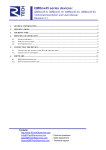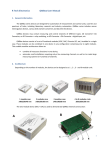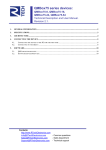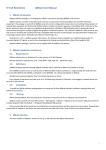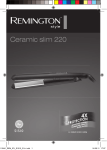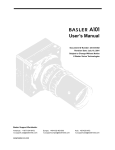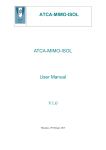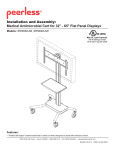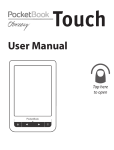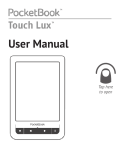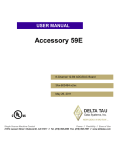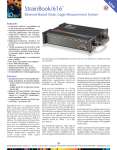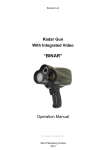Download QMBox Combined Devices User Manual
Transcript
QMBox Combined Devices. Technical Description and User Manual. Revision 2.1. 1. GENERAL INFORMATION .......................................................................................................................................2 2. ARCHITECTURE.........................................................................................................................................................2 3. PRINCIPLE OF OPERATION....................................................................................................................................4 4. SYNCHRONIZATION MODES..................................................................................................................................5 5. FUNCTIONAL MODULES USED IN THE QMBOX SERIES DEVICES .............................................................6 5.1. QMS10 ADC MODULE ............................................................................................................................................6 5.1.1. Specifications..................................................................................................................................................6 5.1.2. Connecting to the object.................................................................................................................................9 5.2. QMS20 ADC MODULE ..........................................................................................................................................11 5.2.1. Specifications................................................................................................................................................11 5.2.2. Connecting to the object...............................................................................................................................14 5.3. QMS45 DAC MODULE ..........................................................................................................................................16 5.3.1. Specifications................................................................................................................................................16 5.3.2. Connecting to the object...............................................................................................................................17 5.4. QMS70 DISCRETE INPUT MODULE..........................................................................................................................18 5.4.1. Specifications................................................................................................................................................18 5.4.2. Connecting to the object...............................................................................................................................19 5.5. QMS75 RELAY SWITCHING MODULE ......................................................................................................................20 5.5.1. Specifications................................................................................................................................................20 5.5.2. Connecting to the object...............................................................................................................................21 5.6. ‘S’ SERIES ADC SUBMODULES ...............................................................................................................................22 5.6.1. S20 – current measurement ..........................................................................................................................23 5.6.2. S30 – voltage measurement ..........................................................................................................................23 5.6.3. S40 – thermocouples interrogation ..............................................................................................................24 5.6.4. S50 – resistance measurement......................................................................................................................24 6. CONNECTION OF THE DEVICE............................................................................................................................25 6.1. 6.2. 7. CONNECTING THE DEVICE TO THE PC FOR THE FIRST TIME ....................................................................................26 CONNECTION TO THE OBJECT .................................................................................................................................28 SOFTWARE.................................................................................................................................................................29 7.1. 7.2. QMLAB SOFTWARE SUITE ......................................................................................................................................29 SOFTWARE DEVELOPMENT KIT ...............................................................................................................................30 Contacts: http://www.R-Technology.ru [email protected] [email protected] [email protected] - Common questions - Sales department - Technical support 1. General information The QMBox series devices are designed for automation of measurement and control units, used for vast spectrum of tasks, including laboratory research and industry automation. QMBox series includes sensor interrogation devices, various A/D and D/A converters and discrete I/O devices. QMBox Combined devices are the multifunctional devices. They may contain measuring and control channels of different types: AD Converter+ DA Converter, or AD Converter + relay switching, or AD Converter + DA Converter + digital input, etc. QMBox Combined devices consist of a set of functional modules (ADC, DAC, Discrete I/O, etc.) installed in a single case. These modules can be combined in one device in any configuration comprising one to eight modules. This scalable modular architecture allows to: • • combine all necessary functions in one device; automate small installations requiring only a few measuring channels, as well as to create large measuring systems for hundreds of channels. 2. Architecture Depending on the number of modules, the device can be designed as a 1 -, 2 -, 3 - and 8-modular unit: 1 module case 140x190x40 mm 2 modules case 140x190x60 mm QMBox Combined Devices User manual 3 modules case 140x190x80 mm Rev. 2.1. 4 to 8 modules crate 260x260x160 mm 2 of 30 The two-module device (ADC + DAC) is used to demonstrate QMBox internal construction: A – the assembled device; В – the same device with the cover removed; 1 – Bottom shell 2 – ADC module 3 – DAC module 4 – Interface board that controls operation of the modules and ensures connection of the device to the computer via USB 5 – Interconnect board that ensures electric connection of the modules to the interface board. Inside the case the modules are plugged into the slots of the interconnect board. This board joins the modules into a single device and ensures electric connection of the modules to the interface USB board. The interface board controls operation of the modules and ensures connection of the device to the PC via USB. QMBox Combined Devices User manual Rev. 2.1. 3 of 30 3. Principle of operation The QMBox series devices operate under PC control (OS Windows) via USB connection. The software supplied with QMBox devices performs stream input / output of data between the device and the PC memory, data processing and further visualization on the display as well as saving to the PC hard disk: QMBox hardware PC USB Object Data processing Sensor signals Digitizing Control signals Control signals generating Data visualization Data saving QMBox devices consist of a set of functional modules (ADC, DAC, Discrete I/O, etc.) installed in a single case. Depending on data transfer direction, all the QMBox modules can be subdivided into input modules (ADC and discrete input modules) and output modules (DAC modules). Before starting work the configuration is performed by means of the software – the operation parameters of the modules of the device are set: sampling rate, the number of channels in use, etc. After this the device is started, i.e. the data transfer session is launched. During the data transfer session the input modules of the device (ADC modules, for example) digitize input signals at a preset rate and send the data through the interface board to the computer via USB. In the PC the data is put to a circular buffer in RAM. During the buffer filling, the data is taken from it by the application software for further processing, visualization and saving to the hard disk. Since the software takes data from the buffer at a rate higher than the rate of its receipt from the device, the data transfer session can last for however long, and data from the device is received by the computer without gaps. Thus, the device can be used as a full-fledged data recorder without record time limits. Output modules (DAC modules) can operate in “stream” mode, too. This mode allows to generate non-periodic signals of arbitrary form and duration and to “play” files of arbitrary length through the DAC. In this mode the data in the internal buffer of the DAC module updates permanently from the PC RAM. The data transfer session can last for however long, and data from the PC RAM passes through the DAC without gaps. QMBox Combined Devices User manual Rev. 2.1. 4 of 30 4. Synchronization modes All the modules installed in the device are clocked by the same generator on the interface board. That is why in the course of work the modules of the device are precisely synchronised with each other. However, sometimes it is necessary not only to synchronize the modules with each other, but to precisely time the entire device to be started by a certain external event. By default the device starts working (i.e. starts the data transfer session) since after issuing the command “Start” from a PC. This command can be executed within a few milliseconds. The exact execution time of this command under OS Windows (that is not a real-time OS) is impossible to be learnt in advance. For the cases when it is necessary to bind the start of the data transfer session to any external event with high precision one can use the external start synchronization mode. In this mode it is necessary to give a negative digital pulse (logical “1” - “0” - “1”) to the "SYN" contact of the device after the issuing the “Start” command. The data transfer session begins right after negative pulse edge (logical “1” to “0”) arrives. The duration of the SYN pulse (i.e. of the logic “0”) must be at least 50 ns. The “SYN” line has an internal pull-up resistor, so one can just short the “SYN” line to “ground” to generate the required pulse. Switching between start synchronization modes of data acquisition is software-selectable. QMBox Combined Devices User manual Rev. 2.1. 5 of 30 5. Functional modules used in the QMBox series devices QMBox Combined devices consist of a set of functional modules (ADC, DAC, Discrete I/O, etc.) installed in a single case. These modules can be combined in one device in any configuration comprising one to eight modules. 5.1. QMS10 ADC Module QMS10 is a multichannel ADC module with 16 differential / 32 single-ended analog inputs. • Max. sampling rate (one channel): 0.4 MS/s • Four input signal ranges: ±10 V, ±2.5 V, ±0.625 V, ±0.156 V (programmable per channel) 5.1.1. Specifications Number of input channels Input signal range (programmable per channel) Max. aggregate throughput (all channels) Max. sampling rate (one channel) ADC resolution 16 differential / 32 single-ended ± 10 V; ± 2.5 V, ± 0.625 V, ± 0.156 V 0.4 MS/s 0.4 MS/s 14 bits 0.7 mV Sensitivity - at input range ± 2.5 V Reference limiting error 0.05 % Typical common-mode rejection ratio (input signal 5 V, 10 kHz) Typical crosstalk (for input signal 10 kHz with channel switching frequency 100 kHz at input ranges ± 10 V; ± 2.5 V, ±0.625 V) Input overvoltage protection: -75 dB -83 dB - Permanent overvoltage (10 sec) - Impulse (1 ms) QMBox Combined Devices User manual ±15 V ±50 V Rev. 2.1. 6 of 30 Figures below show typical characteristics of a QMS10 module: Harmonic distortion; noise in the ½ fADC band; the graph of Crosstalk dependency towards channel switching frequency. Noise in the ½ fADC band (fADC = 400 kHz) Harmonic distortion. Input signal - sine-wave 10 kHz, 3V. fADC = 400 kHz. QMBox Combined Devices User manual Rev. 2.1. 7 of 30 0 -10 Crosstalk, dB -20 -30 x1 x4 x16 x64 -40 -50 -60 -70 -80 -90 0 100 200 300 400 Frequencies of channel switching, kHz Crosstalk dependency towards channel switching frequency. QMBox Combined Devices User manual Rev. 2.1. 8 of 30 5.1.2. Connecting to the object The input port of the QMS10 module is described in the table, where Хn —non-inverting, and Yn — inverting inputs of the differential channel n; NC — the pin is reserved. Pin num. 1 2 3 4 5 6 7 8 9 10 11 12 13 14 15 16 17 18 19 Description +15 V (analog supply) output -15 V (analog supply) output AGND – Analog ground 2 Y16 input Y15 input Y14 input Y13 input Y12 input Y11 input Y10 input Y9 input Y8 input Y7 input Y6 input Y5 input Y4 input Y3 input Y2 input Y1 input Pin num. 20 21 22 23 24 25 26 27 28 29 30 31 32 33 34 35 36 37 Description SYN – synchronization input1 AGND32–ground for single-ended mode X16 input X15 input X14 input X13 input X12 input X11 input X10 input X9 input X8 input X7 input X6 input X5 input X4 input X3 input X2 input X1 input The correct connection of the sources of analog signal is the most important condition of the correct operation of acquisition system which allows to avoid a lot of problems during the device operation. During the connection of the sources of analog signal to the device it is necessary to keep to the following recommendations: 1. 2. 3. 4. Differential connection presupposes measuring voltage difference between the inverting and non-inverting inputs of the channel, i.e. differential voltage. However, it is necessary to remember that the voltage in relation to the analog ground of the device on both inputs (common-mode voltage) should not be higher than the acceptable input signal range. Correct connection of a signal to the differential input is always a three-wire connection. It is necessary to separate signal wires connected to a high-impedance input from the common ground wire. Thus, circuit of high current through signal wires, which reduces measurement accuracy, is eliminated. When several signal sources are connected to the device, it is advisable that their common wires connect at one point only, on the AGND pin of the input port. This will eliminate formation of “ground loops” that are a source of extra noise. The unused analog inputs should be grounded — i.e. just to be connected with AGND pins of the input port. Unused digital inputs could be left disconnected. 1 See Synchronization modes. Allowable potential on the SYN input is 0… 3,5 V relative to the ground (contacts 11, 28). 2 Analog ground is connected to USB ground inside the device. QMBox Combined Devices User manual Rev. 2.1. 9 of 30 On the scheme there are the examples of the correct connection of 1-phase and 2-phase (differential) signal sources to the device. Note that even single-phase signal sources should be connected to a differential input with three wires! The single-phase signal sources The differential signal sources X1 Y1 X1 Y1 ... ... Xn Xn Yn Yn AGND AGND Differential connection of a signal source reduces the level of common-mode noise. Besides, differential inputs allow connecting signal sources so that currents of signal circuits do not flow through a single wire, which increases measurement accuracy. Single-ended input mode permits doubling the number of channels when the use of differential inputs is not required. On the scheme there is the example of the correct connection of 1-phase signal sources to the module in “single-ended” mode: The single-phase signal sources in “single-ended” mode + - X1 Y1 ... + - Xn Yn AGND32 AGND QMBox Combined Devices User manual Rev. 2.1. 10 of 30 5.2. QMS20 ADC Module QMS20 is a multichannel ADC module with 8 differential analog inputs. • High max. sampling rate (one channel): 3 MS/s • Low input current and input capacitance in any operation mode • ADC resolution: 14 bits • Two input signal ranges: ±5 V, ±0.99V (programmable per channel) 5.2.1. Specifications Number of input channels 8 differential Input signal range (programmable per channel) Max. aggregate throughput (all channels) Max. sampling rate (one channel) ADC resolution ± 5 V; ± 0.99 V 3 MS/s1 3 MS/s 14 bits Sensitivity - at input range ± 5 V - at input range ± 0.99 V Reference limiting error 1 mV 0.25 mV 0.05 % Typical input current in any operation mode Typical input capacitance in any operation mode Typical common-mode rejection ratio (input signal 4 V, 10 kHz) Typical crosstalk (for input signal 10 kHz with channel switching frequency 2 MHz) Input overvoltage protection: 0.1 nA 25 pF -75 dB -89 dB ±25 V - Permanent overvoltage (10 sec) ±250 V - Impulse (1 ms) 1 It should be taken into consideration that the overall rate of all the modules of QMBox device cannot be higher then 10 MS/s. For example, if QMBox device contains 4 (or more) QMS20 modules, only three of them can operate with maximum rate (3 Ms/s per module), and other modules of device must operate with rate not exceeding 10 – 3 * 3 = 1 MS/s. QMBox Combined Devices User manual Rev. 2.1. 11 of 30 Figures below show typical characteristics of a QMS20 module: Harmonic distortion; noise in the ½ fADC band; the graph of Crosstalk dependency towards channel switching frequency. Noise in the ½ fADC band (fADC = 3MHz) Harmonic distortion. Input signal - sine-wave 10 kHz, 5V. fADC = 3MHz. QMBox Combined Devices User manual Rev. 2.1. 12 of 30 0 -10 -20 Crosstalk, dB -30 -40 -50 -60 -70 -80 -90 -100 0 1 2 3 Frequencies of channel switching, МHz Crosstalk dependency towards channel switching frequency. QMBox Combined Devices User manual Rev. 2.1. 13 of 30 5.2.2. Connecting to the object The input port of the QMS20 module is described in the table, where Хn —non-inverting, and Yn — inverting inputs of the differential channel n; NC — the pin is reserved. Pin num. 1 2 3 4 5 6 7 8 9 10 11 12 13 14 15 16 17 18 19 Description NC NC NC + 6 V (analog supply) output – 6 V (analog supply) output NC NC NC NC NC AGND – Analog ground Y8 input Y7 input Y6 input Y5 input Y4 input Y3 input Y2 input Y1 input Pin num. 20 21 22 23 24 25 26 27 28 29 30 31 32 33 34 35 36 37 Description NC NC NC NC SYN – synchronization input1 NC NC + 3.3 V (digital supply) output NC AGND – Analog ground 2 X8 input X7 input X6 input X5 input X4 input X3 input X2 input X1 input The analog inputs of the QMS20 module are differential. Differential connection of a signal source reduces the level of common-mode noise. Besides, differential inputs allow connecting signal sources so that currents of signal circuits do not flow through a single wire, which increases measurement accuracy. The correct connection of the sources of analog signal is the most important condition of the correct operation of acquisition system which allows to avoid a lot of problems during the device operation. During the connection of the sources of analog signal to the module it is necessary to keep to the following recommendations: 1. Differential connection presupposes measuring voltage difference between the inverting and non-inverting inputs of the channel, i.e. differential voltage. However, it is necessary to remember that the voltage in relation to the analog ground of the device on both inputs (common-mode voltage) should not be higher than the acceptable input signal range. 2. Correct connection of a signal to the differential input is always a three-wire connection. It is necessary to separate signal wires connected to a high-impedance input from the common ground wire. Thus, circuit of high current through signal wires, which reduces measurement accuracy, is eliminated. 1 See Synchronization modes. Allowable potential on the SYN input is 0… 3,5 V relative to the ground (contacts 11, 28). 2 Analog ground is connected to USB ground inside the device. QMBox Combined Devices User manual Rev. 2.1. 14 of 30 3. When several signal sources are connected to the device, it is advisable that their common wires connect at one point only, on the AGND pin of the input port. This will eliminate formation of “ground loops” that are a source of extra noise. On the scheme there are the examples of the correct connection of 1-phase and 2-phase (differential) signal sources to the module. Note that even single-phase signal sources should be connected to a differential input with three wires! The single-phase signal sources The differential signal sources X1 Y1 X1 Y1 ... ... Xn Xn Yn Yn AGND QMBox Combined Devices User manual AGND Rev. 2.1. 15 of 30 5.3. QMS45 DAC Module QMS45 analog outputs. • • • • • is a multichannel DAC module with 8 independent opto-isolated DAC resolution: 16 bits Output signal range: ±10 V Ultra-low glitch impulse Galvanic isolation of analog outputs from USB Stream output mode allows to generate non-periodic signals of arbitrary form and duration1 5.3.1. Specifications Number of output channels Output signal range 8 ± 10 V DAC resolution 16 bits Aggregate throughput (all channels) Conversion rate (one channel) Max. differential nonlinearity Output voltage settling time (to ±0.0015% of full scale) Typical THD+Noise 1 MS/s 125 kS/s ± 1,5 LSB 2 µs2 83 dB3 Reference limiting error 0.05 % Typical glitch impulse 1.5 nV*s Max. output impedance 0.002 Ω Max. output current (per channel) Galvanic isolation of analog outputs from USB 30 mA 1 kV 1 If QMBox device contains 2 (or more) QMS45 modules, only one of them can operate in stream output mode. Other DAC modules of the device can operate in oscillator mode only. In oscillator mode the module sends the contents of its internal buffer (the buffer size is 32 kSamples per channel) cyclically through the DAC without updating of the output data from PC. This mode is suitable for generating simple periodic signals and DC signals. 2 Output current ≤ 10 mA. 3 Output current ≤ 10 mA. QMBox Combined Devices User manual Rev. 2.1. 16 of 30 5.3.2. Connecting to the object The port of the QMS45 module is described in the table, where where +DACi and –DACi are the outputs of i-channel of the DAC (in a standard variant of the module delivery -DACi is connected inside the module to analog ground AGND). Pin num. 1 2 3 4 5 6 7 8 9 10 11 12 13 14 15 16 17 18 19 Description +DAC1 output AGND – Analog ground +DAC2 output AGND – Analog ground +DAC3 output AGND – Analog ground +DAC4 output AGND – Analog ground +DAC5 output AGND – Analog ground +DAC6 output AGND – Analog ground +DAC7 output AGND – Analog ground +DAC8 output AGND – Analog ground AGND – Analog ground + 15 V (analog supply) output SYN – synchronization input1 Pin num. 20 21 22 23 24 25 26 27 28 29 30 31 32 33 34 35 36 37 Description -DAC1 output AGND – Analog ground -DAC2 output AGND – Analog ground -DAC3 output AGND – Analog ground -DAC4 output AGND – Analog ground -DAC5 output AGND – Analog ground -DAC6 output AGND – Analog ground -DAC7 output AGND – Analog ground -DAC8 output AGND – Analog ground - 15 V (analog supply) output DGND – Digital ground 1 See Synchronization modes. Allowable potential on the SYN input is 0… 3,5 V relative to the Digital ground (contact 37). Note! Digital ground is galvanically isolated from the analog circuits (DAC outputs, AGND) and connected to USB ground inside the device QMBox Combined Devices User manual Rev. 2.1. 17 of 30 5.4. QMS70 discrete input module QMS70 is a multichannel discrete input module with 16 independent, channelto-channel isolated inputs. • Several input ranges: from ± 5 V to ± 220 V • Ability to interrogate the signals provided by both DC and AC voltage • High-voltage galvanic isolation of inputs: 5 kV 5.4.1. Specifications Number of inputs Nominal value of input voltage (depending on the version) Input signals type Minimum value of logical “1” input voltage (depending on the version) Maximum value of logical “0” input voltage (depending on the version) Aggregate throughput (all channels) Sampling rate Galvanic isolation of input channels from USB Channel-to-channel galvanic isolation Input overvoltage protection, impulse 1 ms (depending on the version): 16 ± 5 V; ± 24 V, ± 220 V1 AC and DC ± 4 V; ± 20 V, ± 150 V ± 1 V; ± 5 V, ± 25 V 4 kS/s 0.25 kS/s per channel 5 kV (3.75 kV rms) 500 V ± 25 V; ± 110 V, ± 1000 V 1 Nominal value of input voltage is specified by the customer when ordering. Custom-made versions with other voltage values are available. QMBox Combined Devices User manual Rev. 2.1. 18 of 30 5.4.2. Connecting to the object The input port of the QMS70 module is described in the table, where Хn and Yn — inputs of the discrete channel n; NC — the pin is reserved. Pin num. 1 2 3 4 5 6 7 8 9 10 11 12 13 14 15 16 17 18 19 Description X16 input X15 input X14 input X13 input X12 input X11 input X10 input X9 input X8 input X7 input X6 input X5 input X4 input X3 input X2 input X1 input NC NC NC QMBox Combined Devices User manual Pin num. 20 21 22 23 24 25 26 27 28 29 30 31 32 33 34 35 36 37 Rev. 2.1. Description Y16 input Y15 input Y14 input Y14 input Y12 input Y11 input Y10 input Y9 input Y8 input Y7 input Y6 input Y5 input Y4 input Y3 input Y2 input Y1 input NC NC 19 of 30 5.5. QMS75 relay switching module QMS75 is a relay switching module. It has 8 independent, galvanically isolated relays. • High max. switching voltage/current: up to 400 V / 5 A (per channel) • High-voltage galvanic isolation of relays: 3 kV • Channel-to-channel galvanic isolation 5.5.1. Specifications Number of relays 8 Relay type Electromagnetic Max. switching current Max. switching voltage 3 A (5 A for 1 sec) ±250 V (allowable inductive load switching at overshoot of up to ±400 V) Galvanic isolation of relay channels from USB Channel-to-channel galvanic isolation QMBox Combined Devices User manual 3 kV 750 V Rev. 2.1. 20 of 30 5.5.2. Connecting to the object Default contact configuration (after power on) of each relay: The port of the QMS75 module is described in the table, where NC — the pin is reserved. Pin num. 1 2 3 4 5 6 7 8 9 10 11 12 13 14 15 16 17 18 19 Description К1, Relay #7 К2, Relay #7 К3, Relay #7 К1, Relay #6 К2, Relay #6 К3, Relay #6 К1, Relay #5 К2, Relay #5 К3, Relay #5 К1, Relay #4 К2, Relay #4 К3, Relay #4 К1, Relay #3 К2, Relay #3 К3, Relay #3 К1, Relay #2 К2, Relay #2 К3, Relay #2 NC QMBox Combined Devices User manual Pin num. 20 21 22 23 24 25 26 27 28 29 30 31 32 33 34 35 36 37 Rev. 2.1. Description К1, Relay #8 К2, Relay #8 К3, Relay #8 NC NC NC NC NC NC NC NC NC NC NC NC К1, Relay #1 К2, Relay #1 К3, Relay #1 21 of 30 5.6. ‘S’ series ADC submodules ‘S’ series submodules are single-channel AD Converters designed for measurements with channel-to-channel galvanic isolation, including those for interrogating of remote industrial sensors – thermocouples, thermistors, current loop sensors etc. ‘S’ series common specifications: Sampling rate 0.25 kS/s per channel ADC resolution 12 bits Galvanic isolation of input channels from USB Channel-to-channel galvanic isolation 1000 V 500 V ‘S’ series submodules are installed into slots on QMS301 – Carrier module. One QMS301 module may carry up to 16 ‘S’ series ADC of various types and combined in different ways. Carrier module QMS301 with four ‘S’ series submodules installed is shown below: QMBox Combined Devices User manual Rev. 2.1. 22 of 30 5.6.1. S20 – current measurement S20 is a single-channel ‘S’ series ADC for current measurement. Specifications: Sensor connection 2-wire ADC resolution 12 bits Sampling rate 0.25 kS/s Input signal range 0…20 mA. Custom-made versions with the ranges: 0 … 5 mA, ±5 mA, and ±20 mA are available ±0.075 %. Reference limiting error 5.6.2. S30 – voltage measurement S30 is a single-channel ‘S’ series ADC for voltage measurement. Specifications: Sensor connection 2-wire ADC resolution 12 bits Sampling rate 0.25 kS/s Input signal range ±10 V. Custom-made versions with other ranges, including millivolt ones, are available. ±0.075 %. Reference limiting error QMBox Combined Devices User manual Rev. 2.1. 23 of 30 5.6.3. S40 – thermocouples interrogation S40 is a single-channel ‘S’ series ADC for thermocouples interrogation. All types of thermocouples are supported (according to IEC 60584-1). Specifications: Sensor connection 2-wire Thermocouples type ADC resolution According to IEC 60584-1, including E, J, K, R, S, T, B, N, L, M 12 bits Sampling rate 0.25 kS/s Input signal range -25 mV…+75 mV Reference limiting error ±0.075 %. 5.6.4. S50 – resistance measurement S50 is a single-channel ‘S’ series ADC for resistance measurement, including thermistors. Specifications: Sensor connection 2-wire, 3-wire, 4-wire ADC resolution 12 bits Sampling rate 0.25 kS/s Input signal range 0…250 Ω. Custom-made versions with other ranges are available. ±0.075 %. Reference limiting error QMBox Combined Devices User manual Rev. 2.1. 24 of 30 6. Connection of the device The figure shows the rear panel of a QMBox device: “Link” LED USB Port Power Supply Port “Link” LED — turns on when the device is connected to USB and signals that the USB port of the computer has identified the device correctly. USB port — type B. A standard connector for connecting the device to the PC via USB with an standard USB A-B cable. Power Supply Port — it is used for supplying power from an external supply included in the delivery set. The procedure of connecting the QMBox series devices is as follows: 1. Connect the power supply from the delivery set of the device to the Power Supply Port of the device. 2. Connect the power supply from the delivery set of the device to AC network. 3. Connect the device to the PC via a USB cable. At this the “Link” LED should turn on. When the device is connected for the first time, driver installation might be required. For further information see Connecting the device to the PC for the first time. 4. Connect the signal sources to the device — see Connecting to the object. The procedure of disconnecting the the QMBox series devices is as follows: 1. Disconnect the object (signal sources) from the device. 2. Disconnect the device from the PC. 3. Disconnect the power supply from the AC network. 4. Disconnect the power supply from the device. QMBox Combined Devices User manual Rev. 2.1. 25 of 30 6.1. Connecting the device to the PC for the first time When the QMBox series device is connected to a Windows PC for the first time, it is necessary to specify the location of the device driver. Before connecting the device to the PC for the first time you should first insert the included CD into the CD-ROM drive of your PC and only then connect the device to the PC via a USB cable. As a rule, having detected a new device, Windows starts the Found New Hardware Wizard. In this case you should follow its instructions, choosing not to go to the Windows Update site and specifying the “\DRV” folder on the included CD as the location of the driver. Windows might not start the Found New Hardware Wizard automatically, returning a driver error message in the notification area (in the right bottom corner of the screen): In this case you should start the Device Manager. In different Windows OS versions the Device Manager is started differently. For example, in Windows 7 it can be started by right-clicking the Computer icon, then – Properties, and then – Device Manager. In the Device Manager QMBox device will appear as Unknown device. You should right-click on it and select “Update Driver Software”: QMBox Combined Devices User manual Rev. 2.1. 26 of 30 After this the Found New Hardware Wizard will start up: You should select “Browse my computer for driver software” and specify the “\DRV” folder on the included CD as the location of the driver. Then you should follow the instructions of the Wizard. Once the driver is successfully installed, the “RT USB30K QMSystem Crate Controller USB” device should appear in the Device Manager: This means that the device’s Interface board has been identified correctly by the PC, the driver is installed and the device is ready to work. Afterwards, when the QMBox device is connected to another USB port of the PC, Windows might once again detect the QMBox device as “unknown device”. In this case you will have to repeat the driver installation procedure as described above. QMBox Combined Devices User manual Rev. 2.1. 27 of 30 6.2. Connection to the object The figure shows the front panel of a QMBox device (2-modules model modules): 37 19 20 1 37 19 20 1 Input Ports Every functional module which is a part of the QMBox device has its own input port for the signals connection. The input ports for each module type are described in chapter Functional modules used in the QMBox series devices QMBox Combined Devices User manual Rev. 2.1. 28 of 30 7. Software QMBox software consists of following components: • • 7.1. QMLab software suite Software development kit (SDK package) QMLab software suite The QMLab software suite is a universal software tool for working with QMBox devices. It allows performing most standard tasks within measurement automation. The QMLab suite allows you to start work immediately after the device is connected: acquire, process, visualize and save the already calibrated data converted to the required measurement units without help of programmers or metrologists. The QMLab suite includes: • data recorder; • oscilloscope; • spectrum analyzer; • generator of analog signals; • primary data processing unit. Primary data processing may include calibration, averaging, normalization in accordance with IEC for a specific type of sensor, as well as a more complex mathematical processing. For example, for thermocouples there is an automatic software compensation of cold junction and linearization of the transfer parameter. Obtained data is saved in standard text and binary formats suitable for conventional and specialized data processing programs (Excel, MathLAB, Cool Edit pro, etc.). The generator of analog signals, included in QMLab software suite, supports all QMBox series DAC devices. The program allows you to use the DAC as a multichannel generator of sinusoidal signals, DC signals, as well as signals of arbitrary waveforms (by “playing” through the DAC user’s binary files of arbitrary length). QMLab software suite is free of charge. QMBox Combined Devices User manual Rev. 2.1. 29 of 30 . A detailed description of the QMLab suite is given in the “QMLab User Manual” document that can be found on the site www.RTechElectronics.com and on the CD supplied with the device. 7.2. Software development kit Apart from the complete QMLab software suite, the QMBox delivery set includes an SDK package, which is software and documentation designed for users who would like to create their own applications for working with the device. This software consists of function libraries (API) and examples of software development. The user has a possibility to create full-blown applications using just a limited number of library functions. These library functions are written so that even an inexperienced programmer who is not well-versed in multithreaded and object-oriented programming can work with the device. A more detailed description of the software development kit is given in the “QMBox Programming Guide” document that can be found on the site www.RTechElectronics.com and on the CD supplied with the device. QMBox Combined Devices User manual Rev. 2.1. 30 of 30






























